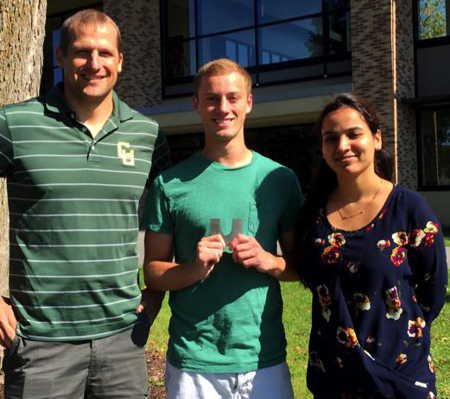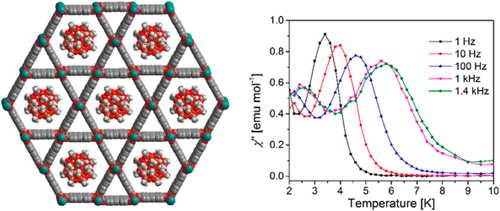Clarkson University Researchers Paper on Ultra-High Density Data Storage Material Design
Metal organic frameworks as platforms for controlled nanostructuring of single-molecule magnets
This is a Press Release edited by StorageNewsletter.com on September 2, 2015 at 2:50 pmClarkson University researchers have published a paper in a prestigious chemistry journal on the design of next-generation, ultra-high density data storage materials.
From left to right, Clarkson University assistant professor of chemistry
and biomolecular science Mario Wriedt, biomolecular science undergraduate
student Joshua Pyser ’16 and chemistry doctoral student Darpan Aulakh
have published a paper on the design of next-generation,
ultra-high density data storage materials in a 2015 issue
of the Journal of American Chemical Society
The article, ‘Metal Organic Frameworks as Platforms for the Controlled Nanostructuring of Single-Molecule Magnets,’ appears in a 2015 issue of the Journal of American Chemical Society.
Mario Wriedt, assistant professor of chemistry and biomolecular science, worked on the paper with Darpan Aulakh (India), chemistry doctoral student, and Joshua Pyser (’16, Dalton, Mass.), biomolecular science undergraduate student, who was funded by a CAMP summer research stipend.
“While data storage density has increased greatly in recent decades due to better technology,” Wriedt said, “this increase won’t continue indefinitely. There is a limit on how small the magnetic domains in traditional hard drives can be before they collapse and make it impossible for computers to read and write data on them.”
“Due to physical limitations, we can’t make these domains smaller than 100 to 200 nanometers because they would lose their magnetic properties,” he said.
Single-molecule magnets, however, behave like traditional magnets and can be tiny as a molecule, Wriedt said. His laboratory now is developing a nanostructuration approach that uses metal-organic frameworks to arrange and protect these magnets.
“A single-molecule magnet can be as small as 1.5 nanometers,” he said. “However, a metal-organic framework is needed to arrange and protect them in a controlled nanostructure, making them usable for real world applications.“
The metal-organic framework significantly enhances the stability of the magnets, which allows for more dense data storage capabilities. Wriedt said the next step in the research is to continue evaluating different structure-property relationships between metal-organic frameworks and single-molecule magnets.
“We have to follow up with a lot of systematic investigation of this,” he said.
Clarkson University launches leaders into the global economy. One in five alumni already leads as a CEO, VP or equivalent senior executive of a company. Located just outside the Adirondack Park in Potsdam, N.Y., Clarkson is a nationally recognized research university for undergraduates with select graduate programs in signature areas of academic excellence directed toward the world’s pressing issues. Through 50 rigorous programs of study in engineering, business, arts, sciences and the health professions, the entire learning-living community spans boundaries across disciplines, nations and cultures to build powers of observation, challenge the status quo, and connect discovery and engineering innovation with enterprise.
Article abstract:
“The prototypical single-molecule magnet (SMM) molecule [Mn12O12(O2CCH3)16(OH2)4] was incorporated under mild conditions into a highly porous metal–organic framework (MOF) matrix as a proof of principle for controlled nanostructuring of SMMs. Four independent experiments revealed that the SMM clusters were successfully loaded in the MOF pores, namely synchrotron-based powder diffraction, physisorption analysis, and in-depth magnetic and thermal analyses. The results provide incontrovertible evidence that the magnetic composite, SMM@MOF, combines key SMM properties with the functional properties of MOFs. Most importantly, the incorporated SMMs exhibit a significantly enhanced thermal stability with SMM loading advantageously occurring at the periphery of the bulk MOF crystals with only a single SMM molecule isolated in the transverse direction of the pores.”
















 Subscribe to our free daily newsletter
Subscribe to our free daily newsletter

